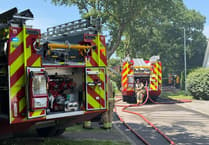ASHWATER Post Office closed on December 22 thus ending an uninterrupted postal service and presence extending for 143 years, writes Ivan Buxton.
In commemoration a pair of 'last day cover envelopes' were posted bearing ordinary 1st class and Christmas 2009 issue 2nd class stamps respectively.
There has been a post office at Ashwater, from at least 1866 but the history of postal services in one form or another goes back many hundreds of years. It was, however, the introduction of the penny post by William Dockra and then introduction of the first adhesive stamp (the old one penny black) by Rowland Hill in 1840, that evolved into the familiar postal service of today.
In 1852 the first red cast iron post box was designed by Anthony Trollope (he was a post office surveyor at the time) and installed in Jersey. Carlisle received the first mainland box in 1853 and the first wall boxes were fitted in 1857.
During 1859 a single style box was introduced. Within a very few years the 'Victorian PO Box' had spread across the nation with the distinctive 'VR' initials. Since then each successive monarch has had his or her initials on boxes erected during their reign. The scarcest are those relating to the ill-fated Edward VII.
The Telegraph Acts of 1868 to 1870 gave Her Majesty's Post Master General the right to operate the inland telegraph system, which meant that post offices became important establishments.
According to Kelly's Directory 1878 to 79 the post office in Ashwater was at John Wadland's house where he traded as a draper, grocer and postmaster.
The entry in Kelly's Directory of 1893 denoted Richard Hocking Moon was now the sub-postmaster and letters were received from Beaworthy RSO and telegraph office at 8.30am; dispatched at 4.55pm. Postal orders were issued but not paid. The sorting and telegraph office were situated at Beaworthy Railway Station.
The letter box, which is still there today, albeit no longer functional, is in the wall of the former shop where Mr Moon also operated as a grocer and seed merchant. The design is typical of the wall boxes in use between 1881 and 1906.
The Devon Records Office contains a bundle of correspondence on establishing a Money Order Office at Ashwater sub-post office, with a deed of arrangement with the GPO dated 1898 to 99.
In 1914 Kelly's Directory shows William Henry Cole as a butcher and sub-postmaster in charge of the post and money office. Letters were still received from Beaworthy, but now arrived at 7.20am; dispatched at 5.50pm — no delivery on Sunday. There were letterboxes situated at Ash Mill, Cross Lanes, Quoditch Moor (this box was in fact in place during Queen Victoria's reign and blown up in 2006 by persons and for reasons unknown), Claw Moor, Rectory Gate and Buckhorn.
On December 29 1919, William Cole resigned and Mr J May, demobilised soldier, was appointed sub-postmaster.
By 1926 the post office was situated at Clifton House and operated by Mr Moon and Kelly's for 1939 confirms Albert E Moon was running a shop and the post office, handling Money Orders and operating the Telegraphic Service until sometime later when it was moved to the premises at Hampden House.
Although Barrie and Hazel Thomas have retired from running the post office and shop, the community are determined that arrangements will be made for a new shop and post office to be set up and operated elsewhere in the village.
The need for both a shop and post office was sharply demonstrated with the recent snowy weather. Cut off from Holsworthy on market day, no bus service and nowhere for parishioners to draw their pensions, let alone buy essential supplies left many wondering what to do. Fortunately Ashwater community spirit remains strong.
A committee appointed following meetings attended by parishioners is actively pursuing a method of funding, erecting and running a new enterprise in 2010. Meanwhile the committee and the members of the parish express their wishes that Barry and Hazel have along and pleasurable retirement.





This article has no comments yet. Be the first to leave a comment.